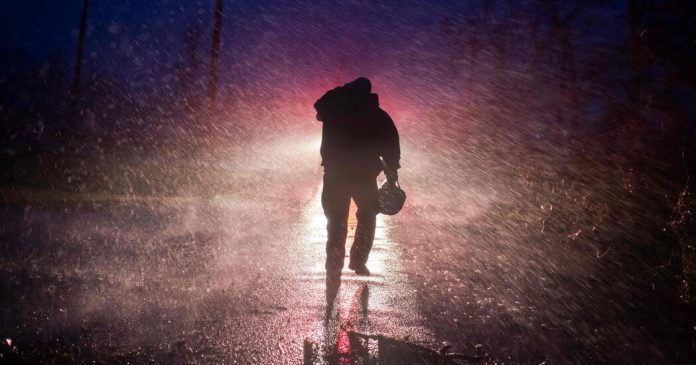Early on Monday, Hurricane Ian was a tropical storm with heavy rain and winds of at the least 73 miles per hour. However specialists say the storm is gaining energy quickly and, if latest historical past is any information, it might intensify dangerously because it nears Cuba as quickly as Monday evening.
As Earth’s local weather warms, extra storms are present process this type of speedy intensification, rising rapidly from comparatively weak tropical storms to Class 3 or greater hurricanes in beneath 24 hours, typically gorgeous forecasters and giving residents little time to arrange.
Listed here are key info about how local weather change can quickly intensify tropical storms.
Warming oceans gasoline greater winds
Greater than 90 % of the surplus warmth from human-caused world warming over the previous 50 years has been absorbed by the oceans. Since 1901, sea floor temperatures have risen a median of 0.14 levels Fahrenheit per decade, in keeping with knowledge from the Nationwide Oceanic and Atmospheric Administration.
That’s essential, as a result of storms collect energy over the ocean. And, the hotter the water, the extra energy they decide up. Greater floor temperatures permit hurricanes to succeed in greater ranges of most sustained wind, a typical metric used to explain the depth of a storm.
“The prevalence of extra intense storms is one thing we’re very assured about,” stated Suzana J. Camargo, a hurricane knowledgeable and professor at Columbia College’s Lamont-Doherty Earth Observatory.
A 2020 satellite tv for pc picture evaluation confirmed that the chance of a hurricane strengthening right into a Class 3 storm or greater, with sustained winds above 110 miles per hour, has elevated by about 8 % a decade since 1979.
These winds intensify extra quickly
Not solely do hotter oceans make storms stronger, they make the speed of intensification extra speedy, stated Kerry A. Emanuel, a meteorologist and hurricane knowledgeable on the Massachusetts Institute of Know-how.
Fast intensification technically refers to a rise of at the least 30 knots, or 35 m.p.h., within the most sustained winds over a 24-hour interval, in keeping with the Nationwide Hurricane Middle. Researchers have discovered that the chance of a hurricane present process speedy intensification has elevated to five % from 1 % for the reason that Eighties.
Various the final decade’s most intense Atlantic storms intensified quickly. Harvey in 2017 was a Class 1 hurricane on the night of Aug. 24; by the subsequent day, when the storm reached Texas, it was a Class 4 hurricane with 130 m.p.h winds. And later that hurricane season, Maria intensified from a Class 1 to a Class 5 hurricane inside simply 15 hours.
In 2021, Hurricane Ida strengthened from a Class 1 with 85 m.p.h. winds right into a near-Class 5 hurricane with 150 m.p.h winds lower than 24 hours later.
Dr. Emanuel stated on Monday morning that present circumstances had been “ideally suited” for Ian to observe the same path of improvement.
It’s not simply hotter oceans
A number of parts aside from ocean temperatures have an effect on hurricanes, and scientists are much less sure about different local weather results.
A type of parts is vertical wind shear, or a measure of how a lot the wind adjustments in pace or path at rising heights within the ambiance. Robust vertical wind shear can inhibit the event of hurricanes by tilting the construction of a storm and by forcing cool, dry air into its core. “It’s like pouring chilly water on a hearth,” Dr. Emanuel stated.
In a 2019 research revealed in Nature Scientific Experiences, researchers discovered that warming temperatures could result in weakening vertical wind shear, permitting hurricanes approaching the East Coast of america to accentuate extra quickly.
Nonetheless, the research’s findings had been localized; totally different results of warming on wind shear could possibly be noticed globally, stated Dr. Camargo, one of many authors of the research.
Quick discover raises the stakes
The rise within the variety of hurricanes that intensify rapidly and unpredictably presents a sticky drawback for forecasters, whose assessments can have an effect on a group’s preparedness.
The window of time to decide will get smaller, Dr. Emanuel stated. For instance, if officers, working with forecasters, problem an evacuation order too early, then they danger unnecessarily sending a whole lot of 1000’s, and typically thousands and thousands, scrambling, jamming highways and snarling transit methods. In some circumstances, that could possibly be extra harmful, disruptive and expensive than staying in place.
“Then, you’ve cried wolf,” Dr. Emanuel stated. The subsequent time the warning to evacuate goes out, folks won’t pay attention.
Make the decision too late, although, and there’s no time for folks to flee the impacts of a dangerously sturdy hurricane.
“It’s a forecaster’s worst nightmare,” Dr. Emanuel stated, for a comparatively weak hurricane to develop right into a Class 4 or 5 hurricane in a single day.


